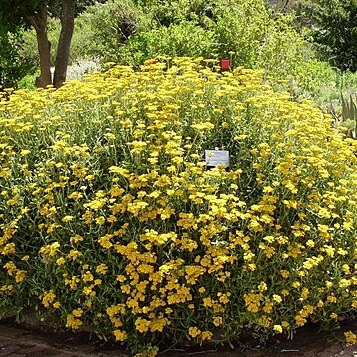Perennial herb or woody herb, 0.3–1 m high, sometimes scrambling to 2 m, erect or sprawling, much branched; stems often decumbent and rooting at the base, glandular, thinly white-or grey-lanate, often winged with thin or broad wings.. Leaves smelling of curry, linear to lanceolate or oblanceolate, 0.5–6 cm long, 0.2–1.5 cm wide, base narrowed or broad and clasping, usually decurrent into stem wings, apex acute or mucronate, glandular and scabrid-pubescent to scabrid-lanate above and glabrescent, grey-white lanate beneath.. Capitula 3–5 mm long, heterogamous, many in dense rounded clusters united in their turn in terminal cymes; receptacle alveolate, fimbrillate; phyllaries closely imbricate and appressed, (narrowly) obovoid, 3–4 mm long, proximal part pale brown, distal part expanded and yellow, apex rounded or obtuse, the outermost lanate at the very base, all others glabrous, the innermost often with a glandular patch halfway.. Outer florets absent (or up to 3, see note), narrowly cylindrical, 2.2 mm long; inner florets (3–)4–6, tube narrowly infundibuliform or cylindrical, (1.6–)2.2–2.4 mm long, lobes 0.3–0.4 mm long and glandular, anthers 1.1–1.4 mm long, style 2–2.5 mm long.. Achenes ellipsoid, 0.5–0.7 mm long, minutely hairy; pappus white, (1.3–)2–3 mm long, coherent at base.. Fig. 87/1–7.
Perennial herb, up to 1.5 m high; stems decumbent and erect, glandular, thinly greyish white-woolly, leafy, becoming pedunculoid upwards. Leaves: blade linear-oblong, lingulate or narrowly obovate, broadest above middle, 5-60 x 1.5-15.0 mm, apex obtuse, sometimes acute, mucronate, base clasping, decurrent in narrow or broad stem wings; upper surface glandular and setose-scabrid, glabrescent or greyish white-woolly on both surfaces, aromatic. Heads disciform, ± 2.5-3.0 mm long, many matted together with wool at base, in dense or loose, flattened or rounded, terminal, cymose clusters. Involucral bracts closely imbricate, innermost ± equalling florets, not radiating, outer pale brown, inner bright or pale canary-yellow, stereome divided. Receptacle epaleate, with fimbrils ± equalling ovaries. Flowers: female and disc florets (3-)7-15, 1-4 female; corolla of disc florets campanulate above, yellow; Jan.-Mar., Jun. Fruit with cypsela hairy. Pappus of many barbellate bristles, bases cohering by patent cilia.
Branched, aromatic herb, base woody, stems often decumbent, rooting, glandular, thinly greyish-white, woolly, leafy below. Leaves variable, 5-60 x 1.5-15.0 mm, linear-oblong to spathulate, base clasping, glandular, setose-scabrid above, greyish-white, woolly, both sides. Capitula 2.5-3.0 mm long, matted together basally with wool in terminal, cymose clusters; involucral bracts imbricate, pellucid, outer pale brown, inner yellow. Receptacle fimbrils ± equalling ovaries. Flowers yellow. Flowering time mainly Jan.-June. Pappus of many bristles, bases cohering by patent cilia. Cypselae 0.75 mm long, barrel-shaped.
Decumbent and erect perennial herb, up to 1.5 m high. Leaves broadest above middle, bases decurrent in narrow or broad stem wings; greyish white woolly on lower surfaces, aromatic. Heads in dense or loose, flattened or rounded, terminal cymose clusters. Flowers yellow; outer involucral bracts pale brown, inner bright or pale canary-yellow.
Straggling, aromatic, thinly white-woolly shrublet to 50 cm. Leaves linear to spathulate, clasping, decurrent, grey-woolly, undulate. Flower heads disciform, densely matted together in terminal cymes, narrowly campanulate, brown and yellow, ± 3 x 2 mm, florets ± 5-15, ovary papillate-hairy.
A herb. It keeps growing from year to year. It grows 1.5 m tall. The leaves are broadest above the middle. The flowers are yellow.

